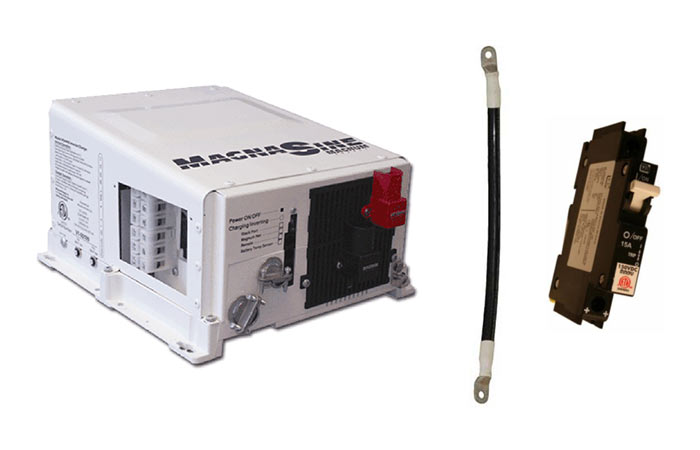Use this table to decide what size battery-to-inverter cables and overcurrent devices (breakers and fuses) to use with your inverter. Remember the fuse and breaker are there to protect your cabling from overheating (and potentially catching fire). You can use smaller cables but only if you in turn use a corresponding smaller breaker or fuse to protect the cable. However, using smaller cables and breaker than what’s suggested can cause problems with your off-grid inverter because the breaker will repeatedly “pop” every time you surge beyond its capacity rating.
| Inverter Voltage | Continuous Watts | Max. Inverter Input Amps (DC) | Fuse Size (DC Amps) |
Circuit Breaker (DC Amps) |
Wire Size (AWG) |
|---|---|---|---|---|---|
| 12V | 600 | 80 | 80 | 80 | 2 |
| 800 | 107 | 110 | 110 | 2 | |
| 1000 | 134 | 200 | 175 | 2/0 | |
| 1500 | 200 | 300 | 250 | 4/0 | |
| 2400 | 320 | 400 | 250 | 4/0 | |
| 2500 | 334 | 400 | 250 | 4/0 | |
| 2800 | 382 | 400 | 250 | 4/0 | |
| 3000 | 400 | 400 | 250 | 4/0 | |
| 24V | 600 | 40 | 50 | 50 | 8 |
| 800 | 54 | 75 | 75 | 4 | |
| 1000 | 67 | 80 | 100 | 2 | |
| 1500 | 100 | 110 | 110 | 2/0 | |
| 2400 | 160 | 200 | 175 | 2/0 | |
| 2500 | 167 | 200 | 175 | 2/0 | |
| 3000 | 200 | 300 | 250 | 4/0 | |
| 3500 | 230 | 300 | 250 | 4/0 | |
| 4000 | 265 | 300 | 250 | 4/0 | |
| 48V | 3000 | 76 | 110 | 110 | 2/0 |
| 3600 | 90 | 110 | 110 | 2/0 | |
| 4000 | 148 | 200 | 175 | 2/0 | |
| 5500 | 185 | 400 | 250 | 4/0 |
Larger cables may used if the distance from your inverter and battery banks is more than 10 feet (~3m).
altE offers battery cables ranging from 1/0 to 4/0 AWG in a variety of lengths for both between your inverter and battery bank and also between your batteries. We also have DC-rated circuit breakers ranging from 1 amp up to 400 amps.



